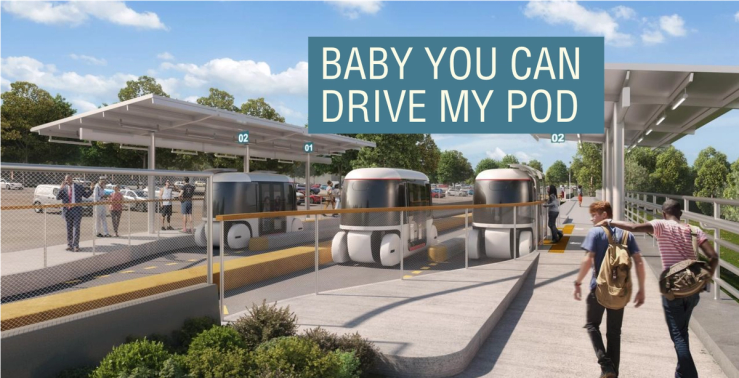The Scoop
Silicon Valley autonomous transportation company Glydways has won a contract to build an experimental, half-mile mass transit system that one day could shuttle travelers the 10 miles between Atlanta’s convention center downtown to its airport, the company told Semafor exclusively.
Backed by venture capitalists like Vinod Khosla and OpenAI CEO Sam Altman, Glydways plans to make small, electric-powered autonomous vehicles that travel along a fixed path. Executives say its compact AVs can move people at rates comparable to rail at a fraction of the cost.
Its shuttles are more narrow than traditional vehicles — about 5 feet wide compared with 8 feet for a Ford F-150, allowing it to shrink the footprint of mass transit. The transport system requires dedicated lanes, such as elevated platforms, and uses small, diagonal pullouts for loading and unloading. The company says Glydways’ infrastructure is less of an eyesore, in part, because it takes up far less space than large parking lots or train and bus stations.
Glydways says its system is capable of carrying 10,000 people per hour in a roughly six-foot-wide lane, although some experts have challenged that. A 12-foot-wide highway lane can carry a max of about 2,200 people, by comparison. Light rail systems can transport about 10,000, but they require an even wider width.
Glydways has two similar programs in the works, including one in the Bay Area connecting the San Jose airport and BART passengers in Contra Costa County. The founders say that using autonomous vehicles on regular, city roads will do little to solve the intractable and growing problem of urban congestion. They also say traditional systems, such as buses and rail, have become prohibitively expensive for cities around the world.
In this article:
Know More
Glydways CEO Gokul Hemmady said in an interview with Semafor that the long-term vision for the company is to start with small pilot programs and then expand to more and more complex networks throughout cities.
Eventually, Hemmady said Glydways vehicles may be able to leave and return to the network to pick up passengers on regular roads.
Investor Khosla has also spoken with Elon Musk about the possibility of using his Boring company tunnel technology to create uninterrupted routes for Glydways traffic.
Unlike normal cars or even autonomous ones, Glydways’ shuttles can be controlled by a central network. While rail systems can be centrally controlled, they are rigid and unable to expand or adapt easily to changing weather conditions.
The Glydways vehicles, by comparison, can be shifted to carry larger groups or families. They can also transport bicycles that can be used to complete the final legs of journeys.
Reed’s view
The fact that Glydways has won three contracts in the space of a year, even if they are pilot programs, is a sign that this kind of technology is gaining mainstream acceptance.
It’s also notable that the most recent win for Glydways is in Atlanta, far from its home advantage in Silicon Valley. It’s also one of the busiest airports in the country.
Personal rapid transit, PRT, systems have earned a dubious reputation among transportation buffs, but there’s an argument that modern technology gets over a lot of the hurdles of past concepts, which relied heavily on rail systems.
A big part of what used to make PRT systems difficult and expensive has now been solved by software. Operating autonomous cars along fixed routes is practically a trivial endeavor these days, and the sensors required are quickly becoming commoditized. Glydways (and its potential competitors) can use a lot of off-the-shelf technology.
Even efficiently planning to handle surges in demand is a fairly easy software fix, thanks to artificial intelligence.
A similar concept is already operational in the United Arab Emirates; Heathrow Airport has used it to replace some buses.
Hemmady’s operating system analogy makes sense in describing how the Glydways network functions. What would make even more sense, though, is for Glydways to eventually open source that operating system or at least license the underlying technology.
If Glydways could create standards and allow other companies to work on and improve various aspects of the technology, it would create economies of scale and allow cities to implement new networks even faster.
If the idea catches on, automakers could build vehicles compatible with the Glydways network, adding to capacity while lowering capital costs for cities.
Room for Disagreement
Streets Blog, which wrote about Glydways last year, quoted experts who were skeptical that Glydways could really transport 10,000 people per hour on its system. One of them, Chris Van Eyken, director of research and policy for the nonprofit Transit Center, said:
“PRT would have to run at incredible frequencies to ensure no waiting. I mean, it’d probably have to have more than one vehicle coming every minute … I think it’s either going to serve a low volume of people, to the point whether you wonder whether it’s worth it, or it’s going to be in high demand and be constantly backed up — and then you’re going to be begging for a larger vehicle.”
Notable
- Glydways won the bid for a route to San Jose’s airport last year, as reported in Bloomberg.


